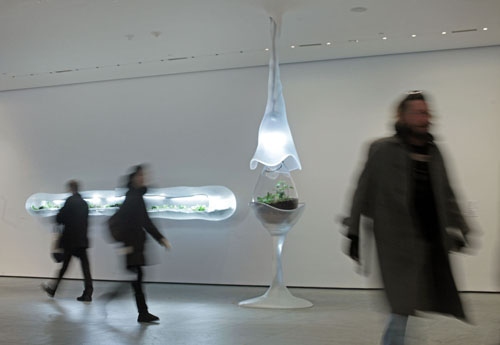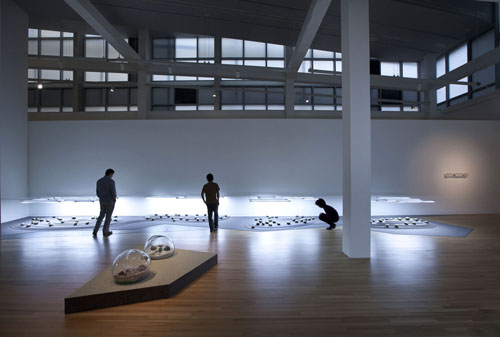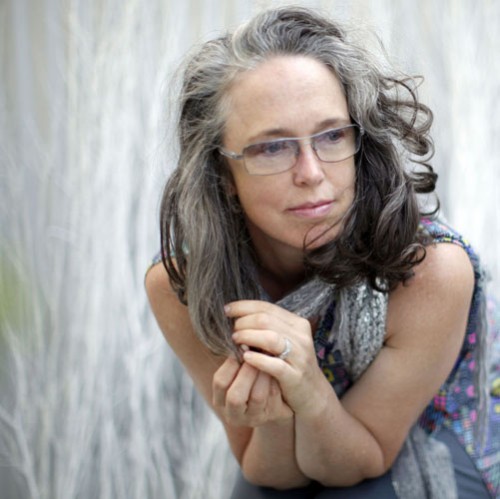Much like the Port Authority Bus Terminal, the lobby of the MoMA is full of people walking from one side of the building to the other. The space doesn’t invite the visitor to sit down, relax, and reflect, but to keep moving to the next destination. Two years ago, however, I found myself motionless inside the MoMA lobby, as I surveyed an installation by New York-based artist Paula Hayes. The installation consisted of two terrariums: a 15-foot-long wall-mounted sculpture and a floor-to-ceiling freestanding egg-shaped structure. Each terrarium contained a variety of living, breathing plant life. Like a stiff jab thrown between an opponent’s gloves, the work stunned me into silence, leaving me weak-kneed. The quasi-egg-shaped vessels were as beautiful and well built as they were weird and mysterious. Paula is a midcareer artist who has built a successful career that combines sculpture, horticulture, and landscape design. Our interview discusses how she cultivates and manages a thriving studio practice without sacrificing artistic integrity, and re-invests earned income to fund new (and experimental) work.
BC: Do you have any projects that you are currently working on? Do you have any shows, commissions, or projects that are lined up that you’d like to plug?
PH: Currently I am in full swing in experimental mode and taking a big risk. I am making some dramatic changes in my work. I am working on a book that is in itself an artwork which will also spawn a series of photographed portraits of the characters in the story. Sculptural works will also be generated as a result of the world I am creating in the story. It all takes place on a nature sanctuary named Lucid Green and takes place in the year 2062. Lucid Green is also the name of the story.

“Nocturne of the Limax maximus,” MOMA lobby commission, New York City, NY, November 16, 2010 – March 30, 2011. Photograph by Béatrice de Géa.
BC: What type of work do you create, and why? As you make the work, do you consider the cost involved in the project? How do you strike a balance between the cost of stuff and the work in the studio?
PH: In the last 10 years I’ve been making sculptural works in organic forms that incorporate living plants and life systems. The care necessary to keep them alive is at the core of the work, as important as the sculptural forms. In the last 7 years I have been making increasingly larger-scale sculptural works in hand-blown glass, cast acrylic and other industrial materials. I also do landscape design. I do works typically, now, for a specific exhibition or for a specific location. I try at all times though to have several projects in the works that are exploratory going on in my studio. I use a great percentage of the profit I make from my work to develop new works. Some works make it to exhibitions or sales, some don’t. I try to be more practical about it but I always end up investing in my own work more than anything else. I do though own a home in Brooklyn with my husband Teo Camporeale. We don’t ever jeopardize our credit or live beyond our means. In other words we live very frugally and invest in new works with whatever money we can.
BC: How much time do you spend making work, and how much time do you spend getting commissions, getting your work out there, in the market, in collectors hands?
PH: Teo, who is a composer and animator and I are collaborative partners in our studio, and we have worked…I shudder to say…7 days a week, 12 hour days, or sometimes longer, most weeks, for the last 5 years. I don’t know what the ratio is regarding how time is parsed regarding what amount of time is devoted to what aspect of making it all work. It can feel overwhelmingly baroque at times, and basically we have to flow with what comes our way. We have studio assistants, many experts help us, but we do everything too.
BC: How do you manage your money, and how do you earn income? I want to know how economics, and money-management, affects your decisions inside and outside the studio.
PH: I manage money by having a bookkeeper and a CPA, I’m organized. I pay a steep overhead to have a studio, it’s a big responsibility. I’m happy to have a great studio though. I didn’t always have one. In the past when my kids were young I worked out of a studio apartment as a single mom, somehow. I’ve just kept going, that’s the secret. The other secret is, no matter what you are doing to survive, stay creatively engaged, say to yourself “this is my art form right now.”
BC: I love your anecdote: no matter what you are doing to survive, stay creatively engaged, say to yourself, “this is my art form right now.” To me, it suggests that you do not place a value system on your creativity. For example, you do not say this is a legitimate work of art, and this is not a legitimate work of art. Everything you produce is part of your art, which is a great mindset. This is more of a comment than a question, but I wanted to bring attention to what you said.
PH: I’ve always earned my income from my creativity. Right now I earn my income from commissions and sales of my sculptural works. I’ve also earned money from designing gardens which I also think of as an art form. It doesn’t matter to me if others don’t think of making gardens as art works, for me it is. I realize as much new work that is experimental as I can based on how much profit I make from commissions. What doesn’t require money: I always have a notebook with me at all times, I mean at all times, especially on the subway. I am literally always sketching and making notes. I also talk to my husband about ideas constantly, we work together and we work and talk about ideas almost all the time.

Installation view of “Hills and Clouds,” part of the solo exhibition “Paula Hayes” at the Wexner Center For The Arts, Ohio State University, Columbus, Ohio, September 16 – December 30, 2011. Photograph by Béatrice de Géa.
BC: To clarify, many of your commissions finance your more experimental work. Am I correct? That type of thinking is as fiscally sound as it is creative. As an artist, have you always been able to balance making art and earning money, or has it been a skill that you acquired through trial and error, or practice?
PH: Yes, my commissions finance my experiments. I would say it’s been a necessity that has developed into the partial skill typical to an over-achiever. I don’t feel that I chose to be an artist. I actually can’t do anything else. I have a particular brain, a particular heart and dare I say, soul, that leads me to do what I have to do to see in the outer world what I see and feel in my inner world. I have a very big drive to make manifest what I feel and see inside.
BC: If you seek monetary compensation as an artist, do you see it as a possible compromise to the type of work you create, and your integrity as an artist?
PH: This is a sad question; how else do artists live if they don’t get money somehow? And basically you have to be in your artistry at all times, I feel, you can’t split your self in two, sometimes an artist sometimes not; no..that doesn’t work. A compromise would be if you did something that you felt was a lie. You can basically tell the truth whatever you are doing: it may have to be done in a way that is done so carefully that only an artist could possibly do it so well under such difficult conditions. But basically there is no excuse to deny beauty its way. It’s not about money, but you need money to eat and have a doctor, help your family, not be dependent on others for basic living, so, you do have to find your way financially. You can do it, you just have to work…a lot.
BC: It is a sad question, but I think it’s a question worth asking. According to an NEA report published in 2011, called Artists and Arts Workers in the United States, the median income for fine artists is $33,982.00 dollars. Most artists I know work a day job, which is unrelated to their studio work. You, on the other hand, are a wonderful example of a successful artist who earns a living doing what you love to do. My question to you: how did you find your way and cultivate your creativity and financial health at the same time?
PH: I grew up on an agricultural farm and I saw my family members work mad hours to keep the farm going. I don’t think this is especially healthy! But…that is how I have lived as well from my creativity; I basically work all the time. The up side is, when it is truly work that I want to do there aren’t enough hours in the day, the day goes too fast, and I can’t get enough. I’m pretty tired right now, but…I am also on fire about Lucid Green, so, I’ll rest later this fall.
To get more specific: there is a lot of trial and error, experimentation, brutal self reflection and evaluation that just takes all you have to get to that higher ground, that pure place where you know you are flying. Was that specific?
BC: Do you work to support your art, or does your art support you?
PC: Both!
BC: As an artist, how do you monetize your time, and how do you assign a monetary value to your studio practice?
PH: I don’t know what this means…but I would say others set the market value of my work, not me, some of the time. Sometimes I use my instincts and it works. Sometimes not.
BC: Let me try to clarify what I was trying to ask you. My friend is a freelance graphic designer. His day rate is $500 while his hourly rate is $75.00 dollars per-hour. He knows the monetary value of his time, experience, and expertise. Do you have a clear-cut figure in your head as to what your work is worth? If you do, how did you arrive at this figure?
PH: My garden design rate has a “market value” hourly rate. I keep time sheets, etc. My artwork is based on some other cryptic system the “art world” developed; I don’t know how that works. Unfortunately for me the fabrication costs of my sculptural works can be so high I don’t make a profit that affords me to live in a way other than frugally since I continually re-invest most of the profit into overhead of a studio and new works. But, I get to have a studio, make new work, so far, and we have a soulful home, good medical care and can be there for our family: it’s the best life I’ve ever had. But, I didn’t grow up wealthy so my perspective is different than someone who did.
BC: What percentage of your income is derived from outside sources associated with your art? Teaching, lecturing, visiting artist?
PH: None, I make all of my income from my work.
BC: The recent economic collapse laid waste to philanthropic giving, government subsidies, and slashed market prices for most artists. As an artist, there are no guarantees. How did you manage the current fiscal crisis, and how did it affect your work inside and outside the studio?
PH: I work all the time, literally, that’s how I do this. It’s never been very easy. I think right now, as an artist you REALLY have to be flexible, open to change, re-inventing yourself, as you are moving fast. This isn’t for the faint of heart, even though very sensitive people do it.
BC: Your comment: This isn’t for the faint of heart, even though very sensitive people do it. It’s provocative. Do you care to elaborate?
PH: It’s very risky, financially speaking, to say the least; to set out to live from what you truly feel is your own truth and sense of beauty. No doubt. Living with so many unknowns, so much possible rejection and possible criticism, is not possible for some psyches. Add it all together and you have quite a cocktail for trouble if you don’t REALLY want to see it through. Which may take decades. And sensitivity is required.
BC: Have you purchased the artwork of another artist? How did your financial investment in another artist’s artwork influence or inform your practice?
PH: I have consistently collected the work of other artists through the years, even the most financially lean years, somehow. I buy the work of younger artists now that I love as much as I can. I love living with it and giving them that encouragement. When I was younger I bought and traded work with some of my contemporaries who have now become very well known. I also store a very large photo of Kirsten Mosher’s that I think I will cry if she comes to get it because I truly cherish it and look at it carefully every day. How has collecting art influenced me; not sure, other than I can’t imagine living without art in my sanctuary. I am not a collector of work that makes me squirm and writhe in intellectual pain, I collect work that adds to the peaceful side of my intellectual wanderlust so it makes sense I like to be near it when I am home. Perhaps that helps me understand that dimension of collecting, but since I stay in touch with my living works and the collectors of my work through the years it is not a foreign thing to me to know how people live with my work, it’s at the very essence of it. The new work I am making is different though, so, perhaps my own collection of art will be helpful in some way: I hadn’t thought about that. Since these are questions about money I just realized you probably want me to address that in collecting art: oh well, I have to run to work!
BC: Any last words?
PH: You know it when you are an artist and the numbers don’t matter, not really. You will find your way, and if you don’t you will be beautiful and angels will take care of you.
Thanks for thinking of me!





Pingback: Work, Get Paid, Re-invest, and Then Work Some More « HE SAID SHE SAID